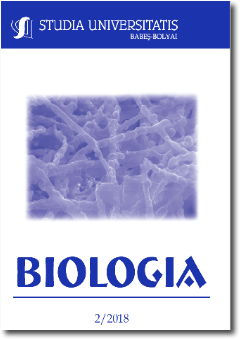Expression of adhesins by some “Bordetella pertussis” strains isolated in Romania in different time periods
DOI:
https://doi.org/10.24193/subbbiol.2018.2.05Keywords:
adherence, fimbriae, pertussis vaccine, virulence factors.Abstract
Bordetella pertussis is the etiological agent of whooping cough or pertussis, a respiratory infection in humans which can be prevented by vaccination. B. pertussis is characterized by a set of virulence factors involved in bacterial adherence to host-cells and consecutive colonization of the respiratory epithelium and in immunity too. In this study, we compared the expression of the specific adhesins with antigenic properties in some B. pertussis strains, including collection strains, vaccine strains and recently-isolated strains. The specific adhesins / surface antigens of B. pertussis are: a surface protein, named FHA (filamentous hemagglutinin) and fimbria Fim2 and Fim3. These antigens were evidenced using an indirect ELISA method, based on specific monoclonal antibodies binding to specific epitopes. The results showed that fimbrial antigens Fim3 are expressed by all new-isolated strains, compared to the older isolates, which expressed Fim2 or both Fim2, 3.
References
Alexander, F., Matheson, M., Fry, N. K., Labram, B., Gorringe A. R. (2012) Antibody responses to individual Bordetella pertussis fimbrial antigen Fim2 or Fim3 following immunization with the five component acellular pertussis vaccine or to pertussis disease, Clinical and Vaccine Immunology, 19(11):1776-1783
Ashworth, L. A. E., Irons, L. I., Dowsett, A. B. (2006) Antigenic relationship between serotype-specific agglutinogen and fimbriae of Bordetella pertussis. Infect Immun., 37:1278–81
Bouchez, V., Guiso, N. (2015) Bordetella pertussis, B. parapertussis, vaccines and cycles of whooping cough, Pathogens and Disease, 73(7):1-6
Bouchez, V., Guglielmini, J., Dazas, M., Landier, A., Toubiana, J., Guillot, S., Criscuolo, A., Brisse, S. (2018) Genomic sequencing of Bordetella pertussis for epidemiology and global surveillance of whooping cough, Emerging Infectious Diseases, 26(4): 988-994
Geuijen, C. A. W., Willems, R. J. L., Mooi, F. R. (1996) The major fimbrial subunit of Bordetella pertussis binds to sulfated sugars, Infect. Immun., 64:2657-2665
Geuijen, C. A. W., Willems, R. J. L., Hoogerhout, P., Pujik, W. C., Meloen, R. H., Mooi, F. R. (1998) Identification and characterization of heparin binding regions of the Fim2 subunit of Bordetella pertussis, Infection and Immunity, 66(5): 2256-2263
Gorringe, A. R., Vaughan T. E. (2014) Bordetella pertussis fimbriae (Fim): relevance for vaccines, Expert Rev. Vaccines, 13(10):1-10
Heikkinen, E., Xing, D. K., Olander, R. M., Hytonen, J., Viljanen, M. K., Mertsola, J., He, Q. (2008) Bordetella pertussis isolates in Finland, BMC Microbiol., 8 (162):1-9
Livey, I., Duggleby, C. J., Robinson A. (1987) Cloning and nucleotide sequence analysis of the serotype 2 fimbrial subunit gene of Bordetella pertussis, Molecular Microbiology, 1(2):203
Mattoo, S., Miller, J. F., Cotter, P. A. (2000) Role of Bordetella bronchiseptica in tracheal colonization and development of a humoral immune response, Infection and Immunity 68(4):2024-2033
Melvin, J. A., Scheller, E. V., Miller, J. F., Cotter, P. A. (2014) Bordetella pertussis pathogenesis: current and future challenges, Nat. Rev. Microbiol., 12(4):274-288
Popovici, O. (2018) Analiza epidemiologica a cazurilor de tuse convulsive intrate in sistemul national de supraveghere in anul 2017, CNSCBT Report
Scheller, E. V., Cotter, P. A. (2015) Bordetella filamentous hemagglutinin and fimbriae: critical adhesins with unrealized vaccine potential, Pathog. Dis, 73(8)
Tsang, R. S., Lau, A. K., Sill, M. L., Halperin, S. A., Van Caeseele, P., Jamieson, F., Martin, I. E. (2004) Polymorphisms of the fimbria fim3 gene of Bordetella pertussis strains isolated in Canada. J. Clin. Microbiol, 42:5364–5367
Vaughan, T. E., Pratt, C. B., Sealey, K., Preston, A., Fry, N. K., Gorringe A. R. (2014) Plasticity of fimbrial genotype and fenotype within populations of Bordetella pertussis: analysis by paired flow cytometry and genome sequencing, 160: 2030-2044
Willems, R., Paul, A., van der Heide, H. G., ter Avest, A. R., Mooi, F. R. (1990) Fimbrial phase variation in Bordetella pertussis: a novel mechanism for transcriptional regulation, EMBO J., 9(9):2803-2809
Zhang, L., Xu, Yi, Zhao, J., Kallonen, T., Cui, S., Xu, Yu, Hou, Q., Li, F., Wang, J., He, Q., Zhang, S. (2010) Effect of vaccination on Bordetella pertussis strains, Emerg. Infect. Dis., 16(11):1695-1701
Downloads
Published
How to Cite
Issue
Section
License
Copyright (c) 2018 Studia Universitatis Babeș-Bolyai Biologia

This work is licensed under a Creative Commons Attribution-NonCommercial-NoDerivatives 4.0 International License.





